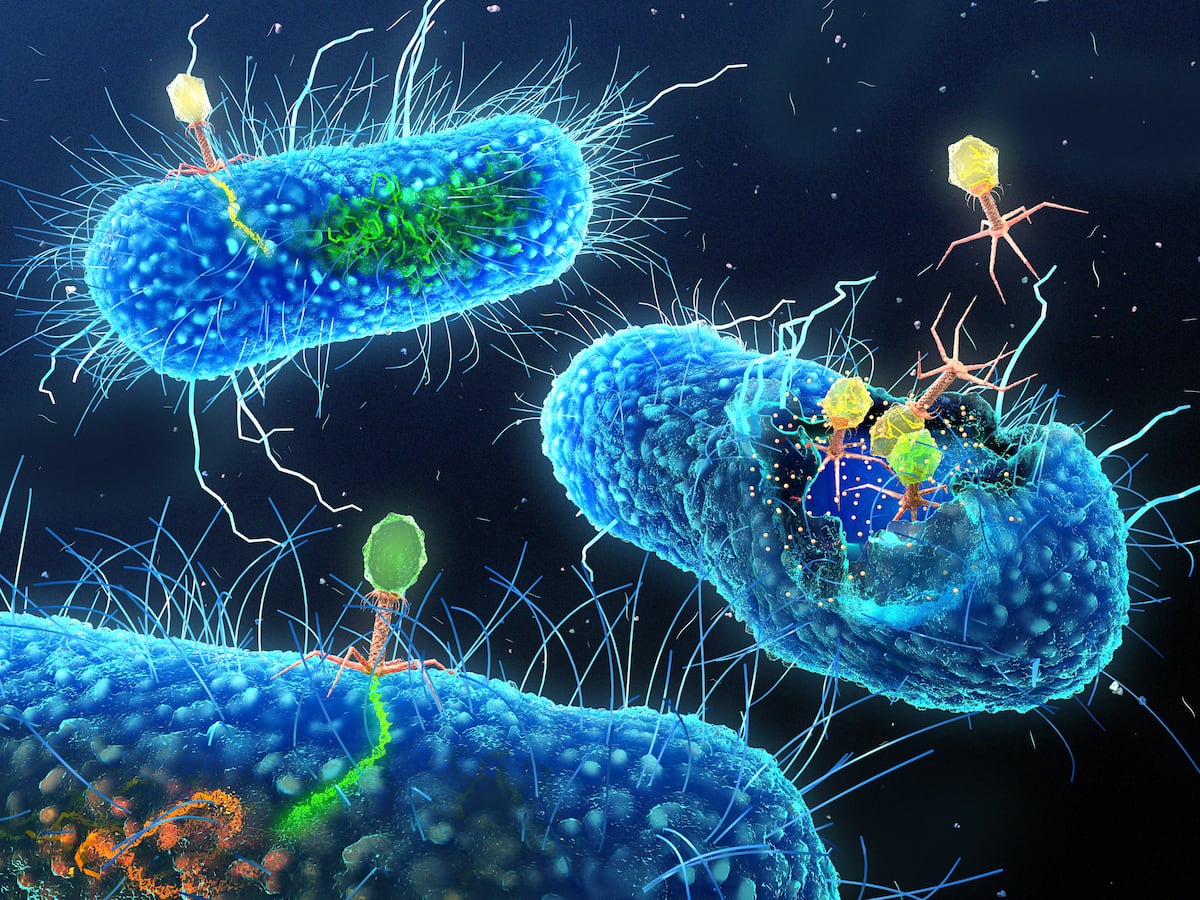The phageome: a hidden kingdom in your intestine | Health and well-being
You’ve probably heard of the microbiome—the hordes of bacteria and other tiny life forms that live in our intestines. Well, it turns out that these bacteria have viruses that exist in and around them, with important consequences for both them and us.
I present to you the phageoma.
Inside the human digestive system are billions, perhaps even trillions, of these viruses, known as bacteriophages (“bacteria eaters” in Greek) or just “phages” to their friends. Phageome (also known as phageme) science has exploded recently, says Breck Duerkop, a bacteriologist at the University of Colorado Anschutz School of Medicine, and researchers are scrambling to understand its enormous diversity. Researchers suspect that if doctors could harness or target the right phages, they could improve human health.
“There will be good phages and bad phages,” says Paul Bollyky, an infectious disease physician and researcher at Stanford School of Medicine. But for now, it’s still unclear how many phages occupy the gut, perhaps one for every bacterial cell, or even fewer. There are also bacteria that contain phage genes, but do not actively produce viruses; Bacteria only live their lives with phage DNA in their genomes.
And there are many phages that have not yet been identified; Scientists call them the “dark matter” of the phageome. An important part of current phage research is identifying these viruses and their host bacteria. The intestinal phage database contains more than 140,000 phages, but this is surely an underestimate. “Their variety is simply extraordinary,” says Colin Hill, a microbiologist at the University of Cork in Ireland.
Scientists find the phages by examining genetic sequences extracted from human fecal samples. That’s where the researchers found the most common group of intestinal phages, called CrAss-phage. Cross-Assembly phagea name due to the “cross-assembly” technique that extracted its genes from the genetic hodgepodge). In a recent study, Hill and colleagues detailed the bulb shape of CrAss-phage, with a 20-sided body and a stalk for injecting DNA into host bacteria.
It is not clear whether CrAss-phage influences human health, but since they infect one of the most common groups of intestinal bacteria, BacteroidsHill wouldn’t be surprised if they did. Other common groups, which also infect to Bacteroidesare Gubaphage (intestinal bacteroidal phage) and LoVEphage (many viral genetic elements).
Phageome vary greatly from one person to another. They also change depending on age, sex, diet, and lifestyle, as Hill and colleagues describe in the Annual Review of Microbiology 2023.
Although phages infect bacteria and sometimes kill them, the relationship is more complicated than that. “We used to think that phages and bacteria fight,” says Hill, “but now we know they’re actually dancing; They are partners.”
Phages can benefit bacteria by providing them with new genes. When a phage particle is assembling inside an infected bacteria, it can sometimes introduce bacterial genes into its protein coat along with its own genetic material. Later, it injects those genes into a new host, and those accidentally transferred genes could be useful, Duerkop says. They could provide resistance to antibiotics or the ability to digest a new substance.
Phages keep bacterial populations in shape by constantly nipping at their heels, Hill says. The bacteria Bacteroids They can have up to a dozen types of sugary coatings on their outer surface. Different coatings have different advantages: evading the immune system, for example, or occupying a different corner of the digestive system. But when there are CrAss-phages around, Hill says, the Bacteroids They must constantly change coats to evade phages that recognize one coat or another. The result: at any given moment, there are Bacteroids with different types of cover, allowing the population as a whole to occupy a variety of niches or face new challenges.
Phages also prevent bacterial populations from getting out of control. The gut is an ecosystem, like the forest, and phages are predators of bacteria, like wolves are predators of deer. The intestine needs phages like the forest needs wolves. When these predator-prey relationships are altered, diseases can occur. Researchers have observed changes in the phageome of inflammatory bowel syndrome (IBS), irritable bowel disease, and colorectal cancer; For example, the viral ecosystem of a person with IBS is usually not very diverse.
People try to rebalance the gut microbiome with diets or, in extreme medical cases, fecal transplants. Studying phages could provide a more refined approach, Hill says. For example, scientists are looking for phages that can be used therapeutically to infect the bacteria that cause ulcers.
Give thanks to the trillions of phages that manage your intestinal ecosystem. Without them, Hill suggests, a few types of bacteria could quickly take over, which could prevent you from digesting some foods and cause gas and bloating. The wild and wonderful phageome is a dance partner for bacteria and humans alike.
Article translated by Debbie Ponchner
This article originally appeared in Knowable in Spanisha nonprofit publication dedicated to making scientific knowledge available to everyone.




Post Comment